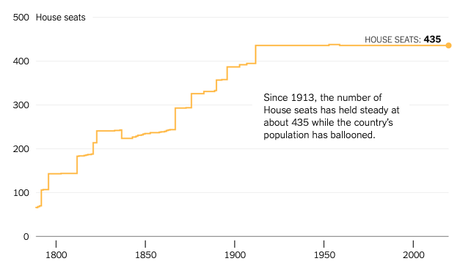
Does this country need a larger House of Representatives? The editorial board of The New York Times believes we do, and they make a good case for increasing it from 435 to 593 members. I agree with them. Here's what they had to say:
We’re nearly two decades into the 21st century, so why is America still operating with a House of Representatives built for the start of the 20th? The House’s current size — 435 representatives — was set in 1911, when there were fewer than one-third as many people living in the United States as there are now. At the time, each member of Congress represented an average of about 200,000 people. In 2018, that number is almost 750,000. This would shock the Constitution’s framers, who set a baseline of 30,000 constituents per representative and intended for the House to grow along with the population. The possibility that it might not — that Congress would fail to add new seats and that district populations would expand out of control — led James Madison to propose what would have been the original First Amendment: a formula explicitly tying the size of the House to the total number of Americans. The amendment failed, but Congress still expanded the House throughout the first half of the nation’s existence. The House of Representatives had 65 members when it was first seated in 1789, and it grew in every decade but one until 1920, when it became frozen in time. There’s a solution, which involves adding 158 new seats to the House of Representatives, making it proportionally similar to most modern democracies. . . . The bottom line is that the House today is far too small, and that poses a big danger to American democracy. For starters, how does a single lawmaker stay in touch with the concerns of three-quarters of a million people? The answer is she doesn’t. Research shows that representatives of larger districts are more likely to take political positions at odds with what a majority of their constituents want. These representatives are also ripe targets for lobbyists and special interests, whose money enables them to campaign at scale, often with misleading messages. Special interests are more likely than regular voters to influence policy positions and votes. Second, the cap on the number of House members leads to districts with wildly varying populations. Montana and Wyoming each have one representative, but Montana’s population — 1.05 million — is nearly twice the size of Wyoming’s. Meanwhile, Rhode Island, which has roughly the same population as Montana, gets two seats. These discrepancies violate the basic constitutional principle of one-person-one-vote, causing voters to be unequally represented in the chamber that was designed to offset the Senate, where every state gets two seats regardless of population. Third, the size of the House determines the shape of the Electoral College, because a state’s electoral votes are equal to its congressional delegation. This is one of the many reasons the college is an unfair and antiquated mechanism: States that are already underrepresented in Congress have a weaker voice in choosing the president, again violating the principle that each citizen should have an equal vote. . . . In 1929, Congress passed a law capping the size of the House and shifting responsibility for future reapportionments onto the Commerce Department. That’s why, more than a century later, we find ourselves with a national legislature far too small to fairly represent both the size and diversity of modern America. This warps our politics, it violates basic constitutional principles of political equality, and it’s only getting worse. There’s a simple fix: Make the House bigger. . . . What is the optimal number of House seats? There isn’t a simple answer. In the Federalist No. 55, James Madison wrote, “no political problem is less susceptible of a precise solution.” By the founders’ own standards, the House could now hold nearly 11,000 members. That’s obviously too many to function. What about returning to the average district size of 1911? That would require more than 1,600 members — still probably too big. There’s a better solution, which involves bringing America into line with other mature democracies, where national legislatures naturally conform to a clear pattern: Their size is roughly the cube root of the country’s population. Denmark, for instance, has a population of 5.77 million. The cube root of that is 179, which happens to be the size of the Folketing, Denmark’s parliament. This isn’t some crazy Scandinavian notion. In fact, the House of Representatives adhered fairly well to the so-called cube-root law throughout American history — until 1911. Applying that law to America’s estimated population in 2020 would expand the House to 593 members, after subtracting the 100 members of the Senate. That would mean adding 158 members. To some, this might sound like 158 too many. But it’s an essential first step in making the “People’s House” — and American government broadly — more reflective of American society today.

